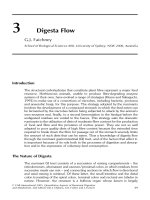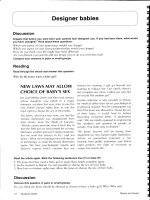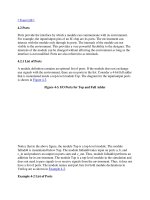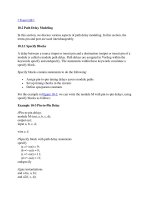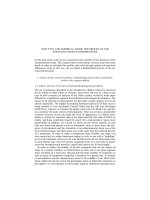vitamins and macro minerals 2
Bạn đang xem bản rút gọn của tài liệu. Xem và tải ngay bản đầy đủ của tài liệu tại đây (1.79 MB, 78 trang )
Chapter 21: Resources of Minerals
and Energy
Introduction: Natural Resources And
Human History (1)
Over one hundred sixty thousand years ago, our
ancestors probably began to use flint, chert, and
obsidian to make tools.
Metals were first used more than 20,000 years ago.
Copper and gold were the earliest metals used.
By 6000 years ago, our ancestors extracted copper
by smelting.
Before another thousand years had passed, they had
discovered how to smelt lead, tin, zinc, silver, and
other metals.
Introduction: Natural Resources And
Human History (2)
The technique of mixing metals to make alloys came
next.
– Bronze was composed of copper and tin.
– Pewter was composed of tin, lead, and copper.
The smelting of iron came much later—about 3300
years ago.
The first people to use oil instead of wood for fuel
were the Babylonians, about 4500 years ago.
The first people to mine and use coal were the
Chinese, about 3100 years ago.
Mineral Resources (1)
Mineral deposits are any volume of rock containing
an enrichment of one or more minerals.
Mineral resources have three distinctive
characteristics:
Occurrences of usable minerals are limited in
abundance and localized at places within the Earth’s
crust.
The quantity of a given mineral available in any one
country is rarely known with accuracy.
Deposits of minerals are depleted by mining and
eventually exhausted.
Figure 21.1
Figure 21.2
Mineral Resources (2)
Ore is an aggregate of minerals from which one or
more minerals can be extracted profitably.
“Ore” is an economic term, whereas “mineral
deposit” is a geologic term.
The economic challenges of ore are to find it, mine
it, and refine it as cheaply as possible.
The lowest-grade ores ever mined—about 0.5
percent copper—were worked only at a time of high
metal prices.
Mineral Resources (3)
In
2002, lowest grade of of mineable copper
ore is closer to 1 percent.
Over production of copper around the world,
combined with economic recession, has resulted
in the closing of many mines, particularly those
exploiting the lowest grades of ores.
Mineral Resources (4)
Sphalerite, galena, and chalcopyrite are ore minerals
from which zinc, lead, and copper respectively can
be extracted.
Ore minerals rarely occur alone.
They are mixed with other nonvaluable minerals,
collectively termed gangue.
–
Gangue may include quartz, feldspar, mica, calcite, or
dolomite.
Origin Of Mineral Deposits (1)
All ores are mineral deposits because each of them
is a local enrichment of one or more minerals or
mineraloids.
Not all minerals deposits are ores.
In order for a deposit to form, processes must bring
about a localized enrichment of one or more
minerals.
Origin Of Mineral Deposits (2)
Minerals become concentrated in five ways:
1. Concentration by hot, aqueous solutions flowing
through fractures and pore spaces in crustal rock to form
hydrothermal mineral deposits.
2. Concentration by magmatic processes within a body of
igneous rock to form magmatic mineral deposits.
Origin Of Mineral Deposits (3)
3. Concentration by precipitation from lake water or sea
water to form sedimentary mineral deposits.
4. Concentration by flowing surface water in streams or
along the shore, to form placers.
5. Concentration by weathering processes to form
residual mineral deposits.
Hydrothermal Mineral Deposits (1)
Some solutions originate when water dissolved in
magma is released as the magma rises and cools.
Other solutions are formed from rainwater or
seawater that circulates deep in the crust.
Mineral deposits formed from midocean ridge
volcanism are called volcanogenic massive sulfide
deposits.
Figure 21.3
Hydrothermal Mineral Deposits (2)
The pyroxene-rich rocks of the oceanic crust yield
solutions charged with copper and zinc.
As a result, volcanogenic massive sulfide deposits are
rich in copper and zinc.
In black smokers, the rising hydrothermal fluid
appears black due to fine particles of iron sulfide
and other minerals precipitated from solution as the
plume is cooled by contact with cold seawater.
The chimney-like structure is composed of pyrite,
chalcopyrite, and other ore minerals deposited by
hydrothermal solution.
Hydrothermal Mineral Deposits (3)
When a hydrothermal solution moves slowly
upward, as with groundwater percolating through an
aquifer, the solution cools very slowly.
If dissolved minerals were precipitated from such a
slow-moving solution, they would be spread over a
large volume of rock and would not be sufficiently
concentrated to form an ore.
Hydrothermal Mineral Deposits (4)
When a solution flows rapidly, as in an open
fracture, or through a mass of shattered rocks, or
through a layer of porous tephra where flow is less
restricted, cooling can be sudden and can occur over
short distances.
Rapid precipitation and a concentrated mineral deposit
are the result.
Veins formed when hydrothermal solutions deposit
minerals in open fractures.
Many such veins are found in regions of volcanic
activity.
Figure 21.5
Hydrothermal Mineral Deposits (5)
The famous gold deposits at Cripple Creek,
Colorado, were formed in fractures associated with
a small caldera.
The huge tin and silver deposits in Bolivia are in
fractures that are localized in and around
stratovolcanoes.
Many famous ore bodies are associated with
intrusive igneous rocks.
Tin in Cornwall, England,
Copper at Butte, Montana, Bingham, Utah, and Bisbee,
Arizona.
Figure 21B1
Figure 21B2
Magmatic Mineral Deposits (1)
The processes of partial melting and fractional
crystallization are two ways of separating some
minerals from other.
The processes involved are entirely magmatic, and
so such deposits are referred to as magmatic
mineral deposits.
Magmatic Mineral Deposits (2)
Pegmatites formed by fractional crystallization of
granitic magma commonly contain rich
concentrations of such elements as:
Lithium.
Beryllium.
Cesium.
Niobium.
Magmatic Mineral Deposits (3)
Much of the world’s lithium is mined from
pegmatites such as those at King’s Mountain, North
Carolina, and Bikita in Zimbabwe.
The great Tanco pegmatite in Manitoba, Canada,
produces much of the world’s cesium, and
pegmatites in many countries yield beryl, one of the
main ore minerals of beryllium.
Magmatic Mineral Deposits (4)
Crystal settling, another process of fractional
crystallization, is especially important in lowviscosity basaltic magma.
One of the first minerals to form is chromite, the
main ore mineral of chromium.
The dense chromite crystals settle to the bottom of
the magma, producing almost pure layers of
chromite.
The world’s principal deposits of chromite are in the
Bushveld igneous complex in South Africa and the Great
Dike of Zimbabwe.


